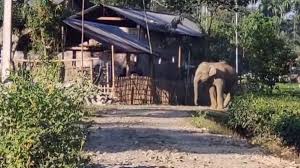In Assam, a distressed and injured elephant has been spotted roaming the streets of Numaligarh, a town located in the eastern part of the state, in search of food. The majestic animal, clearly in pain, is a stark reminder of the rising conflicts between wildlife and human habitation in the region. As its health deteriorates, the elephant’s struggle to find sustenance highlights a growing concern for both conservationists and locals.
The elephant, believed to have sustained injuries in a recent skirmish with a train or vehicle, was first seen near the Numaligarh Tea Estate. The animal was moving cautiously, possibly due to the wounds it had sustained. Experts believe the elephant may have been hit by a moving vehicle while crossing busy roads in the region. Injuries to such animals are common, as roads and railway tracks run through critical wildlife corridors, making it dangerous for elephants and other animals to traverse freely.
As the animal limps through populated areas, residents are fearful of potential confrontations. The elephant, disoriented and in search of food, has been venturing into farms and local shops. The encroachment on human settlements is often triggered by the lack of natural habitats and dwindling food sources in the forest areas. Farmers in the region have reported that elephants frequently raid crops, leading to significant losses, which in turn escalates tensions between the wildlife and local communities.
For elephants, especially those injured and distressed, it is a desperate search for food that often leads them into human settlements. Assam, known for its large elephant population, has witnessed increasing incidents of human-wildlife conflict in recent years. According to forest department officials, elephants traditionally use specific migration routes, but with rapid urbanization and the expansion of infrastructure, these routes have been blocked, leaving elephants with fewer options.
This elephant’s appearance in Numaligarh underscores the urgent need for measures to mitigate human-elephant conflicts. With the growing presence of human settlements along critical wildlife corridors, elephants are increasingly forced into interaction with people. The consequences of such encounters are often tragic, with both animals and humans at risk.
Conservationists have long urged the government and local authorities to implement more sustainable solutions to protect wildlife and ensure the safety of both animals and residents. One such measure is the establishment of wildlife corridors that would allow elephants to move freely without the threat of human interference. These corridors could help reduce the chances of elephants wandering into populated areas in search of food.
Another key factor in reducing conflict is addressing the food shortages in elephant habitats. The loss of forest cover due to deforestation, illegal logging, and the expansion of agricultural land has left elephants with limited access to food and water. The lack of proper habitat management and the depletion of food sources force these majestic animals to venture into human territories, leading to inevitable clashes.
The forest department is currently monitoring the injured elephant’s movements closely. It is expected that a team of wildlife experts will attempt to capture and treat the elephant soon. They hope to provide medical assistance to heal the elephant’s wounds and release it back into its natural habitat once it has recovered. However, experts also warn that this incident reflects a much larger issue that needs immediate attention.
Human-elephant conflict has been an ongoing problem in Assam for years. While the state is home to one of the largest populations of wild elephants in India, the growing encroachment of human settlements into wildlife areas has made peaceful cohabitation increasingly difficult. The Assam government, along with local wildlife protection groups, must take proactive steps to protect both the elephants and the communities that share the landscape.
The injured elephant’s struggle for survival in Numaligarh serves as a poignant reminder of the delicate balance between nature and human development. It is clear that the conflict is not just a concern for wildlife enthusiasts and conservationists but a pressing issue for communities whose livelihoods and safety are intertwined with the health of the region’s ecosystem. Addressing these challenges with urgency and compassion will be key to preventing further escalation of such conflicts and ensuring that both humans and wildlife can live together harmoniously in Assam.




